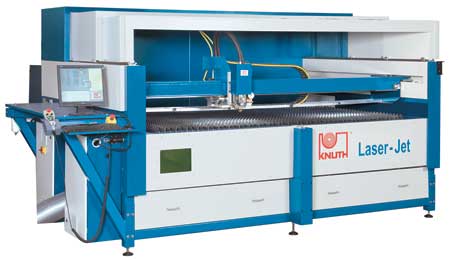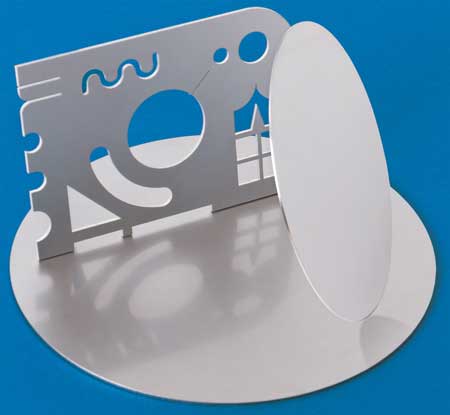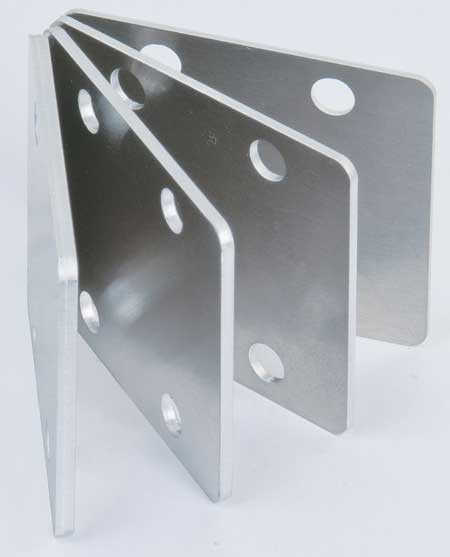

2 mm stainless steel cutters permit high cut quality and complex contours.

Laser cuts in aluminum with a variety of sheet thicknesses.
The compact Knuth Laser-Jet 1512 and 2512 laser cutting units with small footprints and flexibility make them useful in a wide variety of industrial applications for single parts and small batch productions. Allowing a selection between CO2 laser and fiber laser with different beam powers has resulted in a very wide variety of possible cutting applications.
There are different types of laser cutting operations. One is the highly productive cutting, using high-performance machines with a changing table system that allows the laser to be used continuously. Such units are generally used in multiple shift operations, have very high investment costs and are not necessarily meeting the requirements and flexibility of a smaller workshop operation.
The other involves the need for flexibility using a wide variety of materials, cutting qualities and quantities. The development of the Laser-Jet was based on criteria for this type of "workshop operation." The required parts can be produced individually and unloaded directly at the machine. In addition, a sheet of material that has been used for a single part can easily be set aside and later reloaded, which uses up left-over materials at a very high rate.
The Laser-Jet has an ergonomically designed structure for quick loading of sheets and easy unloading of cut parts. "It also includes a well-designed user interface with an integrated technology database for quick, flexible creation of cutting jobs and easy control of cutting operations. A compact design with a small footprint allows space-saving setup and minimum installation site," said the spokesperson.
Both laser types are equipped with a powerful PC base control (GPlus 4000) and handle material sheet sizes up to 8 ft x 4 ft (Laser-Jet 2512) or sizes up to 5 ft x 4 ft (Laser-Jet 1512).
The CO2 laser source (FEHA) is suitable not only for cutting metal, but also for cutting natural materials like wood as well as a large variety of plastics and solid materials or foam. Pieces of Plexiglas up to 30 mm thick can be cut with fully transparent cut surfaces. "In non-alloy or low-alloy structural steels, high cutting power is achieved in plate thicknesses up to 8 mm. The CO2 laser source is available in 600 W, 1,000 W or 1,500 W. Due to the high beam quality of the CO2 lasers used in this process, and the use of a high-pressure cutting head, laser fusion cutting is also possible, using nitrogen under high pressure as cutting gas. High-alloy stainless steel or aluminum materials, in particular the Al alloy AIMg3, can be cut with high quality in plate thicknesses of up to 3 mm. For stainless steel, this means completely blank, oxide-free cut surfaces and burr-free bottom edges," said a company spokesperson.
The fiber laser source (IPG) generates a ten-times-shorter wavelength (1.6 um) than the CO2 laser, so the beam is more focusable. It is better absorbed by metallic materials, which is especially noticeable in materials with strong reflective properties. "Therefore, the Laser-Jet equipped with a fiber laser provides a highly efficient cutting system for stainless steels, aluminum materials as well as copper alloys or copper. Stainless steel, aluminum and brass can be cut in plate thicknesses of up to 6 mm with very high cut quality," said the spokesperson. Even much thicker plates can be cut using the 4,000 W laser source. For non-alloy and low-alloy structural steels, plates over 12 mm thick can be cut. The ytterbium fiber lasers available on the Laser-Jet have beam powers of 1,000 W, 1,500 W, 2,000 W or 4000 W.
For cutting plastics, however, radiation absorption is significantly lower than with CO2 lasers, so the Laser-Jet with a CO2 laser is used for these applications.
Due to its shorter wavelength, the fiber laser requires an optically sealed enclosure on the Laser-Jet. This consists of multiple components, including three upper elements that are telescoped into each other. This happens automatically and sensors verify that the enclosure is fully closed before the cutting process can be started. Upon completion of the cutting job, the enclosure automatically re-opens. When the enclosure is open, the work area for positioning the sheet and removing the cut pieces is freely accessible. The work table therefore does not have to be removed from the enclosure; i.e., no additional space is needed for loading and removal. Additionally, the Laser-Jet work table can also be accessed from the back of the machine through the easily opened rear wall of the enclosure.
Like the CO2 laser, the fiber laser is also mounted on the machine frame of the Laser-Jet and therefore requires no separate storage space. This means that the Knuth Laser-Jet can be transported fully assembled and is ready for operation in no time at all. Demonstrations are available in Knuth's Chicago based facility.
For more information contact:
Knuth Machine Tools USA
590 Bond St.
Lincolnshire, IL 60069
847-415-3333
info@knuth-usa.com
www.knuth-usa.com